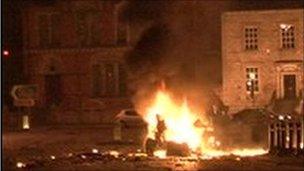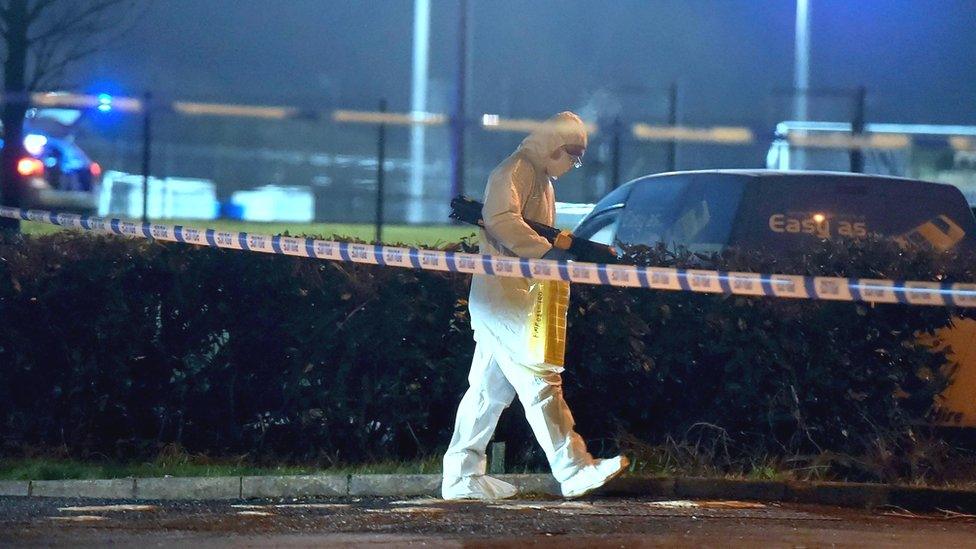NI 2010 review: dissidents republicans pile on pressure
- Published

Newry courthouse: targeted by dissidents
It was a year in which dissident republicans developed the expertise needed to detonate large-scale car bombs and the government warned of possible attacks in Great Britain.
BBC NI home affairs correspondent Vincent Kearney assesses the threat posed by Northern Ireland's terror groups.
It was an easy target. There were no security barriers or checkpoints to negotiate as a car packed with around 250lbs of homemade explosives parked outside Newry courthouse on 22 February this year.
A short time later, as police officers were still trying to clear the surrounding area, the bomb exploded.
No-one was killed or injured, but the shockwaves could be felt more than 40 miles away in the headquarters of MI5 in Holywood and the PSNI in east Belfast.
Two months later, shortly after midnight on 12 April, just minutes after policing and justice powers were transferred to the Stormont Assembly, a similar device exploded outside Palace Barracks, where MI5's huge new offices are located.
Those explosions were described by senior security sources as "game-changing events".
They demonstrated that, after a long period of research and testing, dissident republicans had "got the mix right" - the term used by police to describe the process for successfully constructing and detonating a bomb made from fertiliser.
Capability
The threat posed by dissidents had increased dramatically.
Senior police officers said they regarded it as the most severe since a Real IRA bombing campaign in 1997-1998, when large devices exploded in a number of towns, including Banbridge and Moira, before 29 people were killed in the attack in Omagh in August 1998.
The dissidents' increased technical capability was just one of the issues that alarmed the police and security services during the past year.
There was also increased co-operation between members of the various - previously rival - dissident groups, working together on acquiring weapons, logistics, and planning and carrying out attacks.
The numbers had also grown, with an estimated 600 people believed to be involved.
The PSNI arrested around 80 people in connection with dissident activity during 2010, and Gardai uncovered a number of bomb-making factories and made dozens of arrests, but the dissidents continue to pose a serious threat.

Paedar Heffron lost a leg when a bomb exploded under his car
They know that they don't have to mount large scale bomb attacks to have an impact.
Police officer Paedar Heffron lost a leg when a lunch-box sized device exploded under his car last January.
A number of officers and the partner of another had lucky escapes in attacks using similar under-car booby traps.
Real IRA member and alleged informer Keiron Doherty was shot dead, and others suffered shattered legs and arms in a series of paramilitary assaults on alleged drug dealers.
But it was the technical capability that set alarm bells ringing in London. In September, the head of MI5 said the security services may have initially underestimated the threat posed by dissident groups, which he warned might try to extend their attacks to Great Britain.
Just over a week later, Home Secretary Theresa May announced that the official threat level had been raised from "moderate" to "substantial", meaning an attack in Great Britain was a "strong possibility".
"They have wanted to mount an attack in Britain for a long time now, just like the Provisional IRA did," a senior security source said.
"The difference is that they now have the technical ability to cause large-scale damage.
"Whether that means they also have the operational structures to do so is another matter, but now that they can produce the package, the next step is to work on how to deliver it."
Serious
Publicly the police have consistently said the threat is serious and growing, while stressing that it should be kept in context.
The reality is that while dissident groups have demonstrated that they can kill and maim and detonate bombs, they don't have anything like the capability and capacity of the Provisional IRA during the troubles.
Privately, Chief Constable Matt Baggott spent much of the last year lobbying government for access to more than £200m of additional funding from the Treasury's emergency's reserves to combat the threat.
Some of that funding could be used to employ additional police officers to guard stations and provide close protection for individuals considered to be at high risk of attack. MI5 has also devoted increased resources to countering the activities of dissident groups.
There has been little overt dissident activity in recent months, but security sources fear further attacks early in the New Year because targeting and planning have continued, and a number of competent bomb-makers are believed to be operating within their ranks.
The groups may never achieve the level of capability and capacity of the Provisional IRA, but they don't have to. Their continued existence and occasional activities are enough to cause security and political concern, and to be a constant irritation to Sinn Fein.
The police and security services now talk privately in terms of a five-year strategy to combat the threat.
Some look slightly further ahead to 2016, the 100th anniversary of the Easter Rising, an iconic date in the history of republicanism and one that senior security sources fear will provide a focal point for those groups opposed to the political process.
That level of planning, together with the ongoing discussions about funding arrangements, clearly demonstrate that the dissident threat continues to grow, and could continue to do so for some time to come.
- Published14 August 2023
